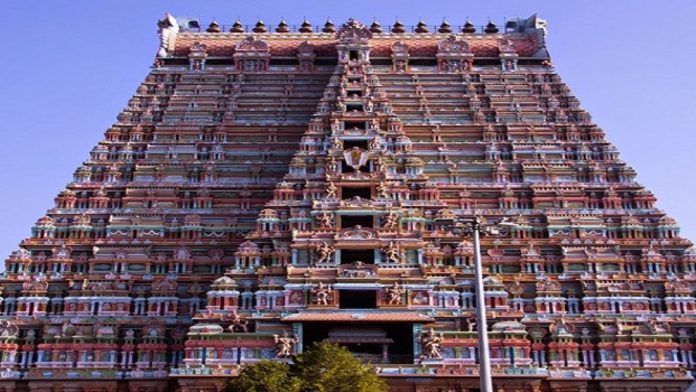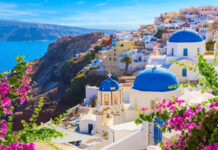An architecture built over 156 acres containing one thousand pillars, 21 towers, 12 tanks, artistically engraved sculptures and many more. No it is not located in the US or in the UK or Spain or China. It’s human tendency to ignore things in front of the eyes and admire those that are not within one’s reach. India known for her rich and cultural heritage is appropriately called the “Land of temples”. Often we fail to appreciate the architecture of temples built thousands of years ago by ancient rulers in the olden days which lacked modern day technology yet it was carved intrinsically with minute details.
Here is one such temple located in the Srirangam city of Tamilnadu in India which has been declared as the World Heritage Site by UNESCO.
About the temple:
Sri Ranganathaswamy temple is also known as Thiruvarangam Tirupathi. It is one of the most important Vaishnava temple dedicated to Lord Vishnu.Lord Vishnu blesses his devotees in reclining form as in the Milky Ocean, the abode of Lord Vishnu (known as Thiruparkadal).This temple is situated in city of Srirangam (in Tamilnadu state) surrounded by river Cauvery on two sides and Kollidam river (which is a tributary of river Cauvery).Hence Srirangam can also be referred to as an Island. The main deities of the temple are Sri Ranganathaswamy and his consort Sri Ranganayaki thayar.
Location of the temple:
The Ranganathaswamy temple in Srirangam is located at a distance of 325km southwest of Chennai and 12 km to the north of the city of Tiruchirapalli (also called Trichy) in Tamilnadu. This city is well connected by Indian railways, buses and airways. In fact the temple can also be reached by landing in Trichy airport and by any means of transportation to Srirangam.
Architecture of the temple:
This temple was constructed in the Dravidian style of architecture. The temple is spread over a massive 156 acres(63 hectares) of land. It has 81 shrines,21 towers and 12 water tanks making Sri Ranganathaswamy temple the “largest functioning temple in the world”.
Salient features describing the intricacies of the architecture:
- Facts prove that though the origin of the temple was during 1st century CE of the Sangam period (it is the period of ancient history of Tamilnadu,Kerala and parts of Srilanka from 6th century BCE to 3rd century CE),due to several invasion, change of rulers and so on several accretion of the temple architecture have taken place. Some of the dynasties who contributed to the temple were the Cholas, the Kongu rulers from Tamilnadu west,the Pandyas from the south,the Hoysalas and the Vijayanagara empire of Karnataka.
- The most prominent feature is, it’s not only a temple but temple town.It has been designed in such a way that there is a sapta prakaram formation which is like a temple centered settlement with rectangular enclosures that run around the sanctum in which the main deity resides.
- Sapta means “seven” and prakaram means “outer path around Hindu temple sanctum”. The inner five enclosures comprise the temple while the other two forms the settlement.
- When one enters these towers, it’s like you are entering the temple premises,
but inside the temple campus there we can find an entire city with streets, shops and houses.
- As per Hinduism the number seven is considered sacred and it symbolically represents the seven elements that make up the human body, the centre of which dwells the soul.
- Apart from the 7 rectangular enclosures(sapta prakaram) there are 21 brightly coloured temple towers,9 sacred pools and 50 sub shrines. The temple town has been well designed and brilliantly executed. The temple towers, tanks and shrines are placed in each of the seven enclosures in a planned manner.
- Another distinctive feature is their mini mandapams (hall like structure) in collinear formation through seven enclosures.
- All the 21 temple towers are embossed with sculptures which pose a challenge to modern day technology. They also provide some clue about trades that took place between countries and how well informed people in those days were.
Detailed description of the the temple architecture
Inscriptions
The inscriptions and the paintings give volumes of the history and culture of the temple over thousands of years ago. The temple abounds in inscription between the early Chola and the late Nayak period. There are over 800 inscriptions out of which 640 are on the walls and the monuments. Most of these inscriptions relate to rewards and grants given by rules or the elite people in their kingdom. Some inscriptions also refer to the management of the temple, scholars, other operations and so on.
The inscriptions are in six major languages Sanskrit, Tamil,Kannada,Telugu,Marathi,Odia.Some inscriptions are in Grantha (an ancient south Indian script in Tamilnadu and Kerala).
The inscription also brings to light that Srirangam was one of the early temples to have had Arogyasala (health center) that provided medical service to the people.
Some of mysterious and fantabulous carvings:
Some of the carvings in the temple indicates that history has to be rewritten in our history books. Presented below are the most prominent ones.
- Carvings of Chinese soldiers:
There is a carving of a Chinese man stabbing an Indian soldier who in turn gets stabbed by another Chinese. Their long droopy moustache and traditional Chinese dress clearly proves they are Chinese men. As per history Faxion was the first Chinese traveler to reach India around 400 AD. But as per record this temple was built at least 300 years earlier.
- Carving of Camel:
It’s known that camels are not native to India. Its believed that camels were brought to India from the middle East,a 1000 years ago.But there is a carving of an animal with a long neck, a hump and flat feet which seems to have been carved almost 2000 years ago. This proves that world was connected even 2000 years back and our country had links with both eastern and western countries.
- Exemplary artistic carvings :
There are some artistic carvings like a one headed monkey with four bodies. When the rest of the sides are covered,one can see a monkey hanging. When everything except the bottom are covered it shows the money in sitting position. When either the left or the right side is covered, it shows the monkey having fun.
A closer look at the above sculpture shows the lifecycle of monkeys or rather human beings in four simple stages. The first stage shows the playful childhood, the second stage shows marriage, the third shows embracing parenthood and the final one, the old age, awaiting death.
It’s still a mystery what types of tools were used in those days for these types of carvings!
- Sculpture with a hidden message?
There is a carving of a weird animal which when covered on one side shows a bull and on the other side shows an elephant. Also there is weird body sculpture embossed which shows two people fighting with swords in one angle and when the top part covered one person has been killed. His upper body is falling on the ground while his legs are still standing.Looks eerie right?
- Other prominent carvings
The temple has 21 towers most of which some extra ordinary carvings and status.Lord Krishna’s life has been portrayed in many of these towers in detail.
Then there is a carving of three people balancing themselves while bending backwards.A closer look at this,we can clearly see even their ribs meticulously carved. Hold on!! It’s not over.
This is actually a crocodile with a monkey inside its stomach. What an imagination and creativity!!
The five holes and three entrance:
Near the inner sanctum of the main deity, on the floor there are five holes in a circle with eight petalled flower. This is enclosed in a circle and then by a square. There are a pair of decorated feet on the northern side.
It is a custom for people who visit the temple to stand on the carved feet, hold your left hand at your back facing backwards, bend down without bending your knees and then put all the five fingers on your right hand in the holes and look through all the three entrances.
There is no exact story of why this is being done though it’s believed that Goddess Ranganayaki was waiting for Lord Ranganatha in this position.
Some believe that there is some underlying benefit of doing this perhaps something connected to our physical balance or the internal energy and so on though there are no evident facts.
Seven Prakars(Enclosures):
As mentioned earlier the entire city is designed within the seven prakars.More details of these prakars are mentioned below :
- First Prakara
The First Prakara (Isthayalogam)is called Dharmavarama Prakara.There is only one entry which is guarded by dwarapalakas named Iyyan and Vijayan, by a gate in its southern part. There are large mirrors which are placed in the corners which are used to reflect the statue of the god as it gets reflected from the sanctum. The shrines of Adhi Varaha,Visvasena,Yoga Narashima and Goddess Durga are located in this prakara.
- Second Prakara:
The Second Prakara (Thapologam) is called Rajamahendran Prakara and is guarded by two dwarapalakans named Pathran and Subathran. It contains two Mandapas “Revathi Mandapa and Kili Mandapa”. Shrines of Senai Mudaliyar, Chera Kula Valli ,Thulukka Nachchiyar found in this prakara.
- Third Prakara:
The Third Prakara (Janalogam) is called the Kulasekara prakara, is guarded on either side by
dwarapalakans. It has the Karthikai Vasal (one of the temple tower). Pavithrothsava mandapa and Dolosthawa mandapa are located in this prakara. Shrines of Haygriva, Sarawathi, Dasamurthi, Kali Devi and Varahamurthi are also present in this prakara. Apart from these shrines and mandapams, the third prakara also contains images of Anjaneya, dwajasthamba and Vaikutavasal.
- Fourth Prakara:
The Fourth Prakara (Maharlogam) is called as the Aalinattan prakaral. Dwarapalakis such as Ganga and Yamuna decorate the entrance. This prakara has shrines of Venugannan(Krishna), Melapattabiraman, Nammalwar, Mathurakavialwar,Thirumangaialwar, Danvantri, Sandana Gopalakrishnan,Vasudevaperumal, Vyasa Maharishi, Varaha Perumal, Varadharaja Perumal, Kothanda Perumal ,Paramapathanathan, Keelapattabiramar, Sreenivasar Bojaramar, Kannan,Thirumalzhisai Alwar, Srikachchi Nambi, Alavanthar, Srivarathar, Garudalwar and Paraman Mandapa.Sacred tanks like Chandra pushkarani(moon pool), Suriya Pushkarni(sun pool) and Sthalaviriksha Tree, named Punnai Tree are also present in this prakara.
- Fifth Prakara:
The Fifth Prakara (Sarvalogam), is called the Akalangan prakara.It is guarded on either sides by Darmaathyashan and Neeyantha dwarapalakas. The Fifth Prakara accommodates shrines dedicated to Andal, Venu Gopalan, Sudarshana, Sriranganachchiyar, Amudhakalasa Garudan, Alakiya Singaperumal, Vasudeva Perumal, Thousand Pillared Mandapa, Shesharaya Mandapa, Kothandaraman, Pillai Lokachariyar, Parthasarathy, Thirupanthalwar, Vittal Krishnan, Thondaradipodi Alwar, Kurathalwar, Thiruvanthikappumandapam, balipitha, Dwajasthampam Kamparamayana Aranketra mandapa and Anjaneya Mandapam.
- Sixth Prakara:
The Sixth Prakara (Poovarlogam) is called the Thiruvikraman prakara.It is guarded with
dwarapalakans named as Chakaram and Sangam on either sides. Manavala Mamunigal Shrine in the Chola Style is located here along with Uttamanambi Shrine, Budhakottam Swami Shrine, Embar Shrine, Sri Ranga Swamy Iyyar Mutt, Bhattar Shrine, Ahobila Mutt, Anjaneya Temple and Ananswami Shrine.
- Seventh Prakara:
This prakara is called the “Adaiyavalanjan ” prakara because it is enclosed itself with another prakara.“Adayavalanjan street”, the functional name meaning encircling space. Adayavalanjan is a Tamil word which is broken as “Adaya” meaning “to seek” and “valanjan” meaning “those who have come”. This prakara is connected with the Rajagopuram(the tallest temple tower).
The Seventh Prakara is known by the name of “Chithirai Thiruveethi”, “Rajaveethi”,”Therodum Veethi”. It is protected by dwarapalakans called Pooranan and Pushkarnan. Srivanamamalai Mutt and Madhvaal Mutt, shrines and halls like Anjaneya Shrine, Hayagriva Shrine,Thirumaligai of Pavanasar, Thaathachchar, Iyyanar, Chithiraidevar, Periyanambi and Kuathalwar are present here.
Mandapams(Halls)
When one hears of Sri Ranganathaswamy temple architecture the first thing that comes to mind are the halls(called as mandapams in Tamil).
- The most prominent of them is the hall of one thousand pillars (1000 pillars though actual figure seems 953).It has been planned in a theatre line structure. It is made up of granite and was constructed during the Vijayanagar period(1336-1565).
- Another artistically designed hall is the one that the Nayaks(a dynasty that emerged in south India after the fall of Vijayanagar empire) added to the complex is the Sesharayar mandapam(hall).The hall is sculpted with leaping animals carved to the piers at the northern end.They are carved out of monolithic pillars.
- Garuda Mandapam(hall) named after Lord Vishnu’s vahana(vehicle) is located on the southern side of the third enclosure.It was also constructed during Nayak’s period.Inside the community hall there are portrait sculptures on its on its pillars middle of which is a free standing-seated figure of Garuda facing the main shrine.
- Killi Mandapam(hall of parrot) is located next to the main deity Sri Ranganatha’s shrine in the first enclosure. Elephant balustrades adorn the steps which lead to a spacious area.This area is bounded by decorated piers with rearing animals.
- Ranga Vilasa Mandapam is a huge one which has sculptures of Ramayana embossed in it.It is the place where weary pilgrims can take rest and also witness the purchase and bargaining of items sold in the shops there.
Shrines:
This temple houses over 56 shrines including the main deity Sri Ranganatha and goddess Lakshmi who is referred as Sri Ranganayaki here. There are also deities for other forms of Vishnu like Lord Hayagreeva, Lord Narasimha, Lord Sudarshana and so on.
The shrine of Lord Venugopala located in the south west corner of the fourth enclosure There is an inscription of 1674 on it.
Temple towers (Gopurams):
There are 21 huge temple towers of which the Rajagopuram(main temple tower) is the largest in Asia and the second largest in the world.It stands tall at 72 metres.This 13 tiers temple tower was completed construction in 1987 though the work started in the last 16th century. The construction work couldn’t be completed earlier due to various reasons. The other 20 temple towers were built between 12th to 17th century. Another prominent temple tower is the white temple tower located on the east side of the fourth enclosure. It has a steep pyramidal superstructure and it at a height of 44 metres.
Fresco paintings
Many of the corridors and halls of the temple are adorned with fresco paintings (it’s a technique of mural painting).The walls of the temple have believed to have been painted using exquisite combination of vegetable and herbal dyes. While they provide evidence of culture and tradition followed in those days, the technologies used pose a challenge to be reproduced in the modern days.
Proofs show that the main deity is not made of granite as in other temples but it is made up of Stucco which is made up of a unique combination of lime mortar and stones held together by a special paste called as “Thailam” which is made of musk, camphor, honey, jaggery and sandal.
Vahanas(Temple Vehicles)
Vahanas also called vehicles are pieces of architecture on which the deities are mounted and carried on shoulders by the devotees. Vahanas are basically wood that are carved into animals,birds,sun,moon etc and elegant gold and silver painting is done on it. Afterwards deities will be carried on it as procession during temple festivals.
The Garuda(bird) vahana, Simha(lion) vahana, Yanai (elephant) vahana, Kudhirai(horse)vahana, Hanumantha(Lord Hanuman) Vahana, Sesha(snake) vahana, Soorya(Sun) and Chandra(moon) are some of the vehicles on which Lord Ranganatha majestically goes on procession during festivals.
The most prominent Vanaha is that of the Elephant(Yanai) vahana. The elephant has four tusks. The four tusked elephants were found to have existed around 38 million years ago and became extinct about 15 million years ago.
Kottarams(Granaries):
The Kottarams or the Granaries provide food reserves to not only to the temple but for the entire temple town.It provides supplies to the kitchen and also serves the needy,travellers and the local residents as well.It has been planned in a systematic manner.
Temple tanks with water harvesting system:
The temple has 12 major temple tanks which are designed with water harvesting system.Of these Surya Pushkarani(sun pool) and Chandra Pushkarani(moon pool) are the largest which harvest most of the water.
Devotional significance associated with the temple:
Sri Ranganathaswamy temple is the only temple out of 108 temples that was sung in praise by all the Alwars (Tamil poet saints who sang in praise of Lord Vishnu).
With so much significance associated with the temple,if you want to know about the mythology of the temple, here you go!
Mythological story of the temple:
It is believed that the main deity of Sri Ranganathaswamy is the ancestral deity of Lord Rama.King Dharamavarman of the Chola dynasty was mesmerised by the deity that he wanted to possess it from King Dasaratha (father of Lord Rama) itself but he refused to part from his ancestral property. Disappointed he returned to his kingdom and did penance to attain the idol.Years later when Lord Rama was coronated as king,during his coronation he gifted it to King Vibhishana to be taken to his Kingdom of Lanka(now Sri Lanka) as per the latter’s desire on a condition that the deity must not be kept down until taken to its destination as once its kept down,it cannot be taken back.
While Vibhishana was crossing south India,as he wanted to do his evening prayers he was looking around as to how to keep the deity safely without keeping it down.
As it was time for king Dharamavarman’s penance to bear its fruit,there came Lord Ganesha in the disguise of a small boy and offered to help Vibheeshana. Vibheeshana handed over the deity to the little boy and cautioned him not to place it down.While he was busy with his evening prayers,the little boy placed it on the ground.Disheartened by his act Vibheeeshana tried to take back the deity but in vain.Lord Vishnu appeared before him and said that while he will stay in that place,he would always have his eyes resting on Srilanka.
Therefore Lord Ranganatha lies in Srirangam with his head on the western side and eyes seeing the south. The entrance to the temple is also in the south and the holy sanctum also faces the southern direction.
Greatly pleased King Dharamavarman built a temple around it. Over the years due to natural calamities and several invasions the temple faced several damages. It was restored back by another Chola king who was popularly known as Kili Cholan (kili means parrot in Tamil) as he was able to discover the temple and restore it back as per a parrot’s advice.
There are so many such temples in India which have rich and cultural identity associated with it but have gone unnoticed. It’s therefore our duty as Indians to bring to the limelight such temples and their glories.
Author: Jayashree Sriram












Outstanding Article.I appreciate the efforts for collecting so much of information about the Ancient temple.Inspired article.Congratulations to Jayashree Sriram. Wish you all the best for outstanding efforts.
Well written! Thanks for collecting so much information and consolidating the same to make it easily available for others. It’s high time we start appreciating our heritage and culture! This is a great head start toward that.
I have read article fully. Author has taken lot of pains to bring out the nuances and minute details of Srirangam Sri Ranganatha Swamy and Temple. My congratulations to Smt Jayashree Sriram for a great effort. I wish she continues to bring about such information about other important Shetrams. With my best wishes Varahaswamy Parthasarathy
Nicely written article
Very nicely written. All the details have been brought out in an exemplary manner.Looking forward for more such articles. All the best!
-Sridharan K
Excellent article. Many unknown facts of the temple have been brought out through this article.Congratulations and all the best for more such informative essays!
Congrats
Very informative.
I think there is no mention about Ramanujar sannadhi
Excellent information As Velukkudi Swami says it would take a month to even understand the exact way to move inside the temple. Really enjoyed reading it.
Kudos to the intricate detail-seeking author who has thrown open a plethora of known and unknown facts about our arangan. The sayana-kola perumal and His shrine may still have many more secrets unravelled. The author’s style of elucidating the salience of the shrine is well appreciated. The author is correct when she expressed the need to relook into a few carvings which could have been misinterpreted and distorted in history. It was an insightful virtual journey that the author had taken me through…
Lots of fact collection has gone towards writing this article. Great job.
Lots of fact collection, compilation done meticulously and presented coherently. Neat work.
Gone thro the article. Nice compilation with lots of inputs. All prakaras, mandapams well explained. Udayavar sannithi and Kambaramaysna mantapam to be added in the next edition. With blessings for more similar coverages.